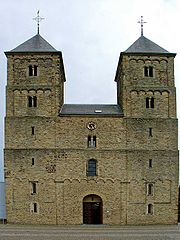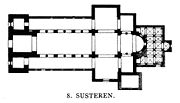
Susteren Abbey
Encyclopedia


Susteren
Susteren is a city in the Dutch province of Limburg. It is located in the municipality of Echt-Susteren, about 7 km northwest of Sittard. It was a separate municipality until 2003, when it was merged with Echt. Susteren received town privileges in 1276....
near Roermond
Roermond
Roermond is a city, a municipality, and a diocese in the southeastern part of the Netherlands.The city of Roermond is a historically important town, on the lower Roer at the east bank of the Meuse river. It received city rights in 1231...
, Limburg
Limburg (Netherlands)
Limburg is the southernmost of the twelve provinces of the Netherlands. It is located in the southeastern part of the country and bordered by the province of Gelderland to the north, Germany to the east, Belgium to the south and part of the west, andthe Dutch province of North Brabant partly to...
, Netherlands
Netherlands
The Netherlands is a constituent country of the Kingdom of the Netherlands, located mainly in North-West Europe and with several islands in the Caribbean. Mainland Netherlands borders the North Sea to the north and west, Belgium to the south, and Germany to the east, and shares maritime borders...
founded in the 8th century. The former abbey church is now St. Amelberga's Basilica.
History
Early in 714 Pepin of Herstal and his wife PlectrudePlectrude
Plectrude was the wife of Pepin of Herstal, the mayor of the palace and duke of the Franks, from about 670. She was the daughter of Hugobert, seneschal of Clovis IV, and Irmina d'Oeren....
sent Saint Willibrord letters of conveyance and protection for the monastery, permitting free election of abbots. The Benedictine foundation served as a refuge for the missionaries working in Friesia
Friesia
There are 2 plant genera named Friesia, of different authority:*Friesia Spreng., a synonym of the genus Croton of the Euphorbiaceae.*Friesia Fric There are 2 plant genera named Friesia, of different authority:*Friesia Spreng., a synonym of the genus Croton of the Euphorbiaceae.*Friesia Fric There...
and the Netherlands.
It was destroyed by the Vikings in 882 and refounded as a house of secular canonesses, whose first abbess
Abbess
An abbess is the female superior, or mother superior, of a community of nuns, often an abbey....
was Saint Amelberga of Susteren
Amelberga of Susteren
Saint Amelberga of Susteren was the Benedictine abbess of Susteren, Netherlands in the 9th century CE. She died about 900. Her feast is celebrated on November 21.Two daughters of the King of Lorraine, France, were educated in her abbey....
. She died about 900.
The Lotharingia
Lotharingia
Lotharingia was a region in northwest Europe, comprising the Low Countries, the western Rhineland, the lands today on the border between France and Germany, and what is now western Switzerland. It was born of the tripartite division in 855, of the kingdom of Middle Francia, itself formed of the...
n King Zwentibold
Zwentibold
Zwentibold was the illegitimate son of the Carolingian Emperor Arnulf of Carinthia. In 895 his father, then king of East Francia, granted him the Kingdom of Lotharingia, which he ruled until his death.After his death he was declared a saint and martyr by the Catholic Church.- Life :Zwentibold...
, a benefactor of the abbey and either the father or the brother of the abbesses Benedicta and Cecilia, was buried (according to a later tradition) in Susteren Abbey in about 900.
Also buried there are Saint Wastrada, who died in the mid-8th century, and Saint Gregory of Utrecht (d. about 775/777), a companion of Saint Boniface
Saint Boniface
Saint Boniface , the Apostle of the Germans, born Winfrid, Wynfrith, or Wynfryth in the kingdom of Wessex, probably at Crediton , was a missionary who propagated Christianity in the Frankish Empire during the 8th century. He is the patron saint of Germany and the first archbishop of Mainz...
in his missions to Friesia, and later abbot of the Martinsstift in Utrecht
Utrecht (city)
Utrecht city and municipality is the capital and most populous city of the Dutch province of Utrecht. It is located in the eastern corner of the Randstad conurbation, and is the fourth largest city of the Netherlands with a population of 312,634 on 1 Jan 2011.Utrecht's ancient city centre features...
.
The abbey was suppressed at the end of the 18th century when the French Revolution
French Revolution
The French Revolution , sometimes distinguished as the 'Great French Revolution' , was a period of radical social and political upheaval in France and Europe. The absolute monarchy that had ruled France for centuries collapsed in three years...
spilled over into the Low Countries
Low Countries
The Low Countries are the historical lands around the low-lying delta of the Rhine, Scheldt, and Meuse rivers, including the modern countries of Belgium, the Netherlands, Luxembourg and parts of northern France and western Germany....
. The church alone remains.
St. Amelberga's Basilica
The abbey church, one of the major examples of Romanesque architectureRomanesque architecture
Romanesque architecture is an architectural style of Medieval Europe characterised by semi-circular arches. There is no consensus for the beginning date of the Romanesque architecture, with proposals ranging from the 6th to the 10th century. It developed in the 12th century into the Gothic style,...
in the Netherlands, although marred by a poor restoration in 1885-1890, was built in the 11th century. It was clearly influenced by the Ottonian
Ottonian
The Ottonian dynasty was a dynasty of Germanic Kings , named after its first emperor but also known as the Saxon dynasty after the family's origin. The family itself is also sometimes known as the Liudolfings, after its earliest known member Liudolf and one of its primary leading-names...
minster church of Essen Abbey
Essen Abbey
Essen Abbey was a collegiate foundation for women of the high nobility in Essen. It was founded in about 845 by the Saxon Altfrid , later Bishop of Hildesheim and saint, near a royal estate called Astnidhi, which later gave its name to the religious house and to the town...
. It was dedicated to Amelberga in 1886, after authentication of the relics kept here. On 6 September 2007 the church was declared a basilica minor.
Sources
- Habets, J.J., 1869: Bijdragen tot de geschiedenis van de voormalige stad Susteren en van de adellijke vrouwenabdij Sint-Salvator aldaar, Publications de la Société Historique et Archéologique dans le Limbourg 6 (1869), 441-567.
- Koldeweij, A.M., and van Vlijmen, P.M.L. (eds.), 1985: Schatkamers uit het Zuiden. Tentoonstellingscatalogus Rijksmuseum het Catharijneconvent (pp. 83-92, 97-104, 165-167). Utrecht
- Roozen, N., 1960: Uit de schatkamer van de oude abdijkerk van Susteren. Harreveld
- Sangers, W., and Simonis, A.H., 1958: De kerk van Susteren. Karolingische familieabdij. Adellijk vrouwenstift. Parochie. Susteren
External links
- Susteren Abbey Church (private interest site)
- Digitaal Vrouwenlexicon van Nederland: Life of Saint Amelberga of Susteren

